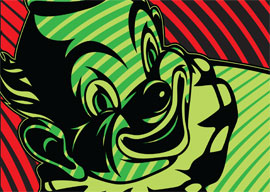
August 19, 2013

Source: Shutterstock
Yes, it is true that serial killer John Wayne Gacy was a part-time children’s party clown who murdered 33 people. It’s also true that continental Europe’s most famous clown of the 19th century, Jean-Gaspard Deburau (AKA “Pierrot”), killed a young boy with one cruel blow from his walking stick.
But certainly such monsters are the exceptions rather than the rule, despite the media’s obsessive focus on the myth of the “evil clown.” For every Gacy and Pierrot, there are a thousand honest, hardworking, pure-hearted clowns who seek to bring joy and laughter to a world that often gives them nothing but scorn and fear in return.
“Coulrophobia” is the word used to describe an irrational fear of clowns, a fear that is compounded by societal prejudices that refuse to even acknowledge the word’s existence in dictionaries and medical diagnostic manuals. If you suffer from coulrophobia, you should beware that it is not an officially recognized disorder and will not even be covered under Obamacare.
Just as science has shown that infants can be racist, a study in England concluded that “clowns are universally disliked by children.” And unless such thought disorders are treated early, they can metastasize into full-blown bigotry and violence once the child reaches adulthood.
Such hatred is evident even in Sarasota, FL, the fabled “Circus Capital of the World,” which on a sane and just planet would be a safe haven for clowns, a sort of Israel for the clowning community. But in 2006 when city planners announced they were going to erect nearly six dozen life-size clown statues in the downtown area, the public outcry was nearly as ferocious as the infamous Tulsa Race Riot of 1921. One unidentified Sarasotan reportedly threatened to run over the clown statues with his car. Many of the statues wound up being vandalized.
Tragically, many clowns have internalized the hatred that society directs toward them, leading to schisms within the clowning community itself. In a recent CNN op-ed, a woman responded to the Obama rodeo clown fiasco not by admonishing society, but by scolding her comrade in clownsmanship:
As part of our training, and really the training of most clowns, we have a strict code of ethics covering such things as drinking while clowning, cleanliness and remaining in character. We take offense at the actions of the rodeo “clown” because we are strictly trained not to offend anyone while “in clown.”…Real clowns have clown hearts long before we put on makeup.
As a child attending the Ringling Brothers and Barnum & Bailey Circus at the Philadelphia Spectrum, I was emotionally touched by the desperately forlorn face of a “hobo” clown who resembled the legendary Emmett Kelly, Jr. His face spoke of defeat, resignation, and a thousand heartaches, recalling the etched-in-pain misery on the faces I’d seen in pictures of black sharecroppers in the racist American South. In the end, I suppose, there’s not much difference between Emmett Kelly and Emmett Till.
I, for one, am tired of seeing clowns portrayed as fools, freaks, and buffoons. They should be taken seriously, and a phrase such as “just clowning around” should be called out for the hate speech that it is. The word “bozo” should not be an insult. We should cease treating clowns as cultural “others” merely because their features and apparel are different than ours. Hiding in fear behind their self-imposed lily-white makeup and bulbous red noses, they should be treated with the same honor and respect as the transgendered. Rodeo clowns, especially, should be honored rather than mocked for doing the work that normal Americans just won’t do.
I stand before you all today to declare that I am unafraid of clowns and will do my best to fight this unjust and hurtful societal phobia.